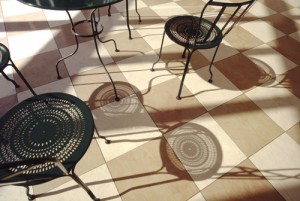I stumbled across Rearranging the Chairs as an Act of Leadership and got to thinking. The gist of this intriguing post (by management consultant CV Harquail) is that “how we sit is how we interact.” People sitting in a circle interact differently than people sitting in a square, or on two sides of a desk.
That feels true—but not in a simple way. I can remember being in a group interview (three team members evaluating me as a potential fourth) at a round table. In that instance, the circle didn’t feel communal a bit. In fact it seemed like my three interviewers had me surrounded and were closing in for the proverbial kill. Would it have been different without the table? Possibly. Or it may be that three against one is always unbalanced. Or it may have been the personalities of those three people.
(Although I did get the engagement, my sense of unbalance wasn’t wrong. I learned later that I was a hit with two team members, a wide miss with the third.)
In any event, “moving the chairs” may not be about physically arranging the seating. Maybe it’s just a way of putting some thought into the environment, and the dynamics you want for a group situation. Does anyone really think about the best space for an interview—or just the convenient (i.e., available) space? A large proportion of interviews seem to take place in empty meeting rooms, with interviewer and interviewee perched on two of twenty chairs; or in a cubbyhole with two chairs and a bare table; or in someone’s imposing office, with a big chair, a little chair, and a yard of desk in between.
None of those arrangements seems very conducive to authentic communication.
It’s likely that most companies could do a better job of arranging the interview environment if they just gave it a little thought. Which would only happen if they thought it was important—so we’ll have to wait for a study that shows better hires come from better interview ambience. Until then, there’s the phone.
Seriously. Many companies are concluding that first (and often second) interview rounds are not only more efficient by phone, but also more productive. As noted entrepreneur Guy Kawasaki points out in a New York Times “Corner Office” conversation, “when you interview in person, many variables come into play that have nothing to do with competence.” Since lots of factors can “sidetrack” the interviewer in a person-to-person meeting, Kawasaki favors a process that begins by asking every candidate a checklist of questions on the phone.
So moving the chairs could also be removing the chairs. There’s not one perfect seating plan, but it does matter who sits where.
(Thanks to globevision for the charming chairs.)
Cynthia Giles has followed a serpentine career path from academia to publishing to marketing and design to information technology and corporate communications. There’s plenty of detail about this journey at www.cynthiagiles.com, but briefly--the common theme has been ideas, and how to present them effectively. Along the way, she became an accidental expert on data warehousing and business intelligence, and for the past ten years she has combined corporate contracting with an independent consulting practice that focuses on marketing strategy for smaller businesses and non-profits.
Having spent quite a bit of time looking for work, and anywhere from two weeks to two years inside a wide variety of American companies—she has given much thought to what works (and what doesn’t) when it comes to creating a great employment fit.
